Applications are closed for this year, but any outstanding graduating PhD students in computational physics should next year!
13.10.2025 13:56 — 👍 0 🔁 0 💬 0 📌 0
Editorial: DCOMP's 2025 Rahman and Metropolis Awards
Phys. Rev. E 112, 030001 (2025)
Just spotted this editorial on the
@apsphysics.bsky.social
DCOMP Metropolis and Rahman awards!
I was happy to share some thoughts with
André Schleife & Koblar Alan Jackson who put this editorial-interview together, along with Chris Van de Walle.
journals.aps.org/pre/abstract...
13.10.2025 13:55 — 👍 0 🔁 0 💬 2 📌 0
Nice!
30.09.2025 08:01 — 👍 0 🔁 0 💬 0 📌 0
Yes!
Doped and ShakeNBreak manage other parts of the defect workflow, such as defect enumeration, symmetry, thermodynamics etc, along with input file generation and calc parsing - e.g. doped has been used with AiiDA, atomate2, quacc etc, so they are complimentary to its functionality!
30.09.2025 01:41 — 👍 3 🔁 0 💬 1 📌 0
We briefly mention the development of workflow tools and high throughput studies as one of the motivating factors for better reproducibility and established guidelines, but don't go into more detail on their use as we're not the experts there!
30.09.2025 01:35 — 👍 2 🔁 0 💬 0 📌 0
Thanks Janine!
Yes absolutely, workflow tools should definitely be able to help for reproducibility and throughput here. I think defects are a challenge to workflow tools given the many steps and complexities, but definitely still doable
30.09.2025 01:35 — 👍 2 🔁 0 💬 1 📌 0
Led by @agsquires.bsky.social with myself, @aronwalsh.github.io & @scanlond81.bsky.social
29.09.2025 12:25 — 👍 3 🔁 1 💬 1 📌 0
Very gracious for David to let me off the leash on this one. Kick-started an agyrodite obsession (though I may be a bit late to the party on this one)
13.03.2025 20:26 — 👍 9 🔁 4 💬 0 📌 0

JPhys Energy proudly presents the 2025 Emerging Leaders Collection, a showcase of groundbreaking research from early-career scientists shaping the future of energy.
Explore the collection and meet this year’s winners: ow.ly/74fs50WP55y
01.09.2025 13:31 — 👍 1 🔁 1 💬 0 📌 1
Thanks Andrew!!
13.09.2025 16:54 — 👍 1 🔁 0 💬 0 📌 0
Thanks very much David! Tried to run into you at Psi-k to say hello but didn't get to!
13.09.2025 16:53 — 👍 1 🔁 0 💬 0 📌 0
Certainly not news to anyone who knows me 😅
But please share with prospective students! 🙌
11.09.2025 14:29 — 👍 1 🔁 1 💬 0 📌 0
I am incredibly grateful for the support of my mentors, collaborators, friends and colleagues over the past few years – too many to tag, beyond the main ones:
@scanlond81.bsky.social @aronwalsh.github.io @boriskozinsky 🙌
11.09.2025 14:29 — 👍 2 🔁 1 💬 1 📌 0
sam-lab.net (Please share!)
Our lab – the Simulation of Advanced Materials (SAM) Lab – will use state-of-the-art computational methods to design and develop next-generation materials; primarily targeting energy applications ⚡️
11.09.2025 14:29 — 👍 2 🔁 1 💬 1 📌 0

I will be joining the University of Cambridge as an Assistant Professor in the Yusuf Hamied Department of Chemistry! 🧪🎉
𝐈 𝐚𝐦 𝐚𝐜𝐭𝐢𝐯𝐞𝐥𝐲 𝐫𝐞𝐜𝐫𝐮𝐢𝐭𝐢𝐧𝐠 𝐬𝐭𝐮𝐝𝐞𝐧𝐭𝐬, and am very keen to support fellowship applications – visit our website for details! ⬇️
11.09.2025 14:27 — 👍 53 🔁 14 💬 5 📌 1
LinkedIn
This link will take you to a page that’s not on LinkedIn
...more recently 𝗡𝗲𝗾𝘂𝗜𝗣 & 𝗔𝗹𝗹𝗲𝗴𝗿𝗼 (nequip.readthedocs.io), using foundation models we have been training with the accelerated infrastructure, now on Matbench Discovery: matbench-discovery.materialsproject.org
08.09.2025 12:35 — 👍 0 🔁 0 💬 0 📌 0
LinkedIn
This link will take you to a page that’s not on LinkedIn
This work made heavy use of 𝗱𝗼𝗽𝗲𝗱 (defect simulation package – lnkd.in/eU4pggmg), 𝗠𝗔𝗖𝗘 (MLIP – lnkd.in/eHBXxhxV), some 𝗦𝗵𝗮𝗸𝗲𝗡𝗕𝗿𝗲𝗮𝗸 (defect structure-searching – lnkd.in/earFF_sX) and...
08.09.2025 12:35 — 👍 0 🔁 0 💬 1 📌 0
Thank you for the feature IOP Publishing!
I'm honoured to be included in the Emerging Leaders collection.
Article Link: (identifying split vacancy defects with electrostatics, DFT & MLIPs): lnkd.in/eEdrB2pk
08.09.2025 12:34 — 👍 1 🔁 0 💬 1 📌 0
Have a read if you're interested!
15.07.2025 13:38 — 👍 0 🔁 0 💬 0 📌 0
I think this shows exciting potential for MLFFs in defect modelling, but with caveats... they fail dramatically for non-fully-ionised charge states where localisation matters! They work here due to the enormous configuration space but with relatively simple underlying energetics
15.07.2025 13:38 — 👍 0 🔁 0 💬 1 📌 0
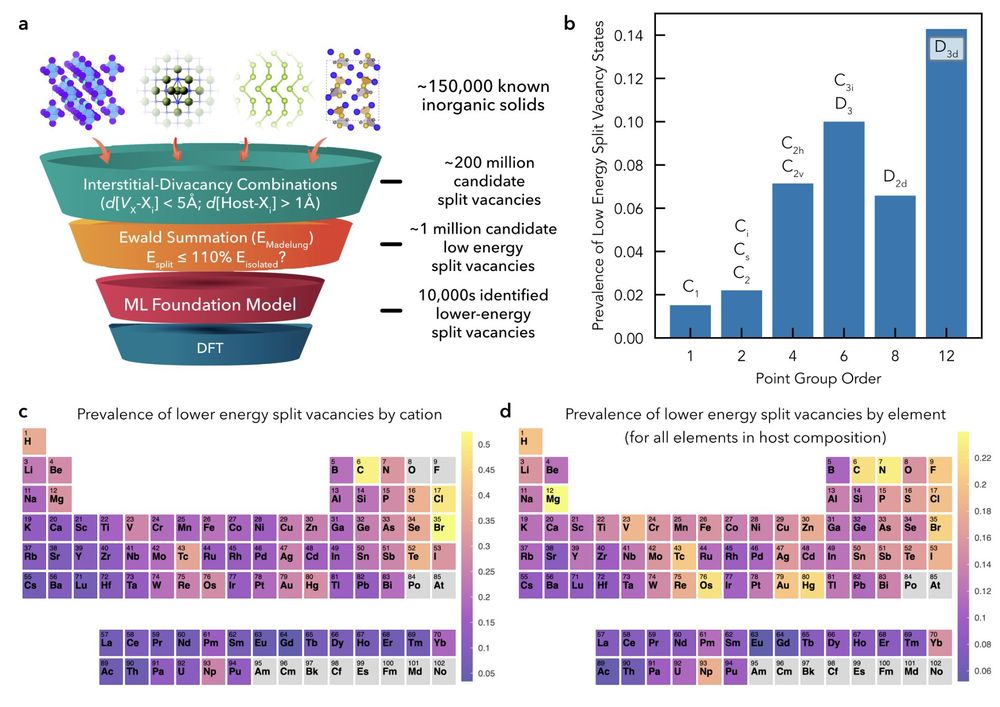
This allows an efficient tiered screening; scanning 𝘢𝘭𝘭 compounds in the ICSD & Materials Project database for split cation vacancies
15.07.2025 13:38 — 👍 0 🔁 0 💬 1 📌 0
Indeed, due to the relatively simple underlying energetics (primarily electrostatics and strain), this problem is well-suited to MLIPs. I find that foundation models (MACE, NequIP, Allegro -- stayed tuned for the latter!) successfully predict split vacancy formation in most cases
15.07.2025 13:38 — 👍 0 🔁 0 💬 1 📌 0
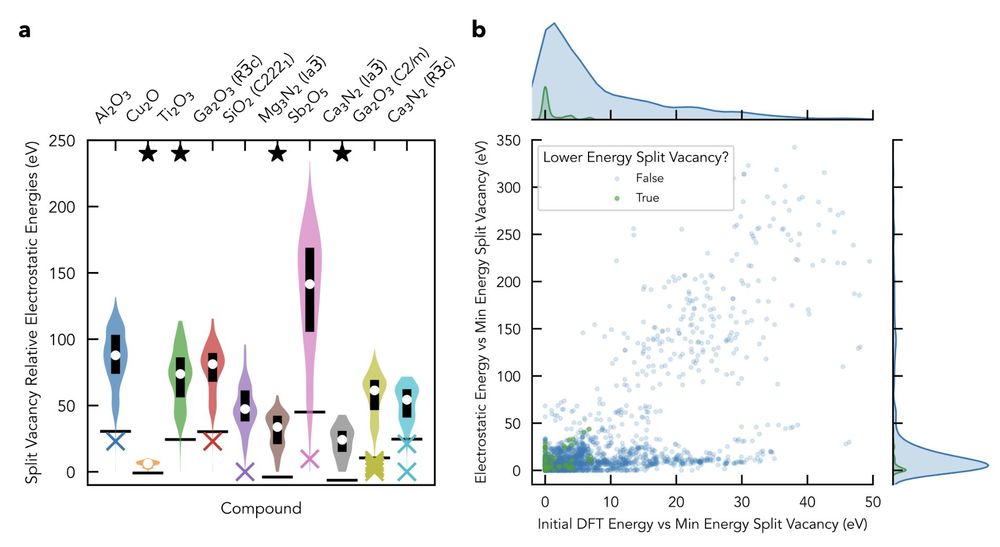
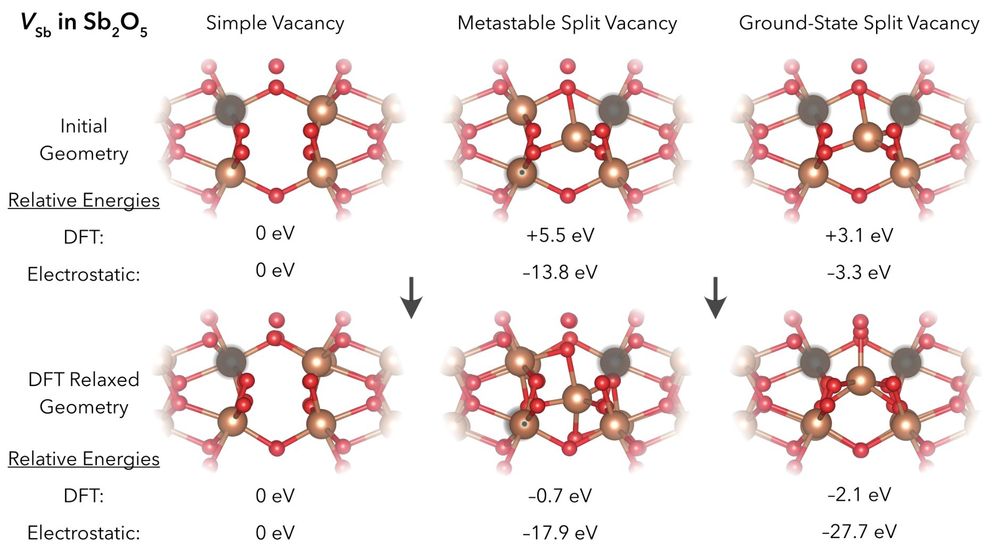
We can't just enumerate all potential split vacancy configurations; the search space is enormous (>1000s of candidate geometries per defect). I find instead that electrostatic models can greatly reduce this space, as electrostatics dominate energetics for these 'stoichiometry-conserving' complexes
15.07.2025 13:38 — 👍 0 🔁 0 💬 1 📌 0
Unfortunately, they are very challenging to identify with current defect structure-searching methods (e.g. 𝗦𝗵𝗮𝗸𝗲𝗡𝗕𝗿𝗲𝗮𝗸) due to their 'non-local' nature, as most of these methods employ some form of 'local' structure searching techniques
15.07.2025 13:38 — 👍 0 🔁 0 💬 1 📌 0
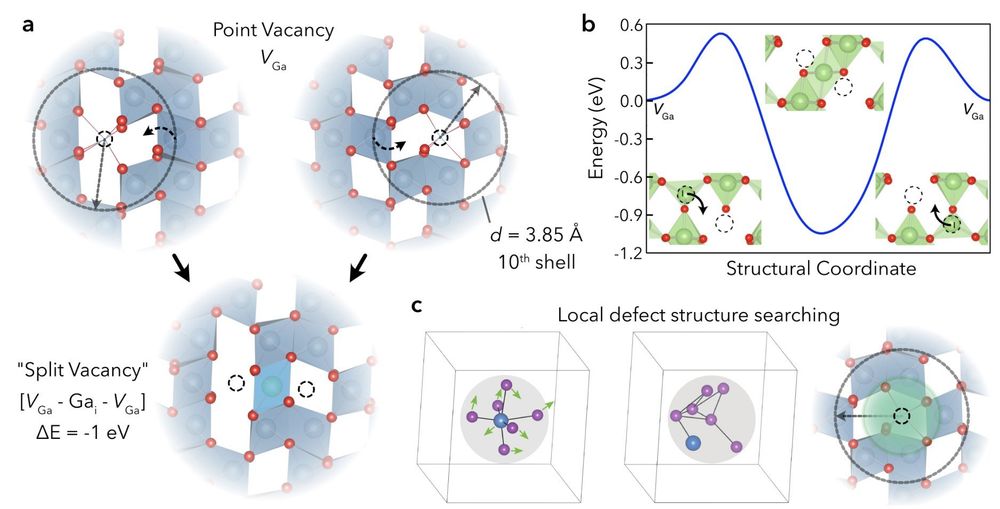
Vacancy defects can sometimes transform to split-vacancies, with dramatic changes in energy & behaviour, e.g. in Ga₂O₃ as discovered by Joel Varley. They have only been witnessed in a handful of cases – are they inherently rare or have we just not had the tools to find them?
15.07.2025 13:38 — 👍 0 🔁 0 💬 1 📌 0
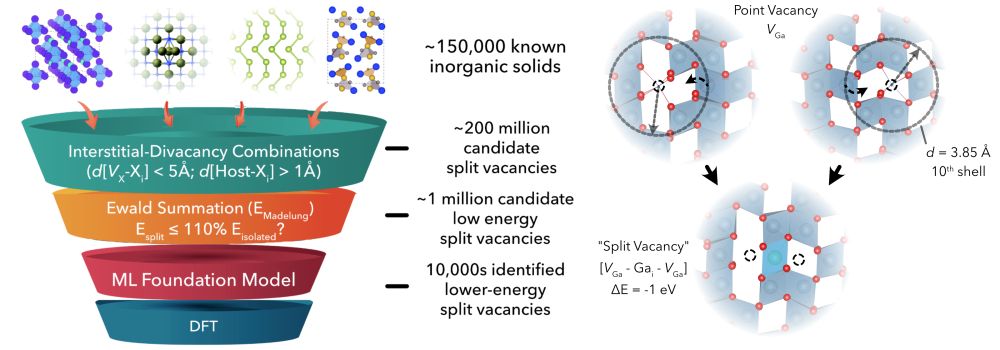
Machine learning can be powerful for modelling defects, but currently only in select cases.
MLIPs (& geometric/electrostatic tools in doped) allow screening for challenging 'non-local' defect reconstructions (split vacancies) in all ICSD/MP solids, w/caveats
iopscience.iop.org/article/10.1...
15.07.2025 13:38 — 👍 2 🔁 0 💬 1 📌 0
Collaboration with @uclchemistry.bsky.social @imperialmaterials.bsky.social @upc.edu @unibirmingham.bsky.social
02.07.2025 14:04 — 👍 0 🔁 0 💬 0 📌 0
Materials scientist. Professor at the University of Twente.
Passions: Materials Science and Painting.
Looking at the periodic table as a paint palette and applying creativity in both, science and art.
Chemistry. Science conferences. Faraday Discussions. Trees. Border collies. Archaeology. Scuba. Not necessarily in that order.
Working at FH Münster | non-crystalline Matter does not really exist for me | occasional cycler
Associate Professor of Computational Chemistry, University of Birmingham
https://www.grynova-ccc.org/
views my own
▪️P @icreacommunity.bsky.social & UdG Prof TheoChem
▪️S @spinstatepapers.bsky.social
▪️F @rsc.org
▪️M @acad-euro.bsky.social
▪️E @ica-papers.bsky.social
▪️ORCID: https://orcid.org/0000-0002-8174-8488
▪️🇳🇱 Views my own
▪️Pronouns: he/him/his
▪️Web: @marcelswart.eu
Was a theoretical chemist, now I wrangle ML models for materials science. Enjoy a hike every now and then. He/him.
Professor at Cambridge University, Fellow of St Edmund's College, Student of Everything Else. Posting in a personal capacity; opinions and photographs my own.
www.ch.cam.ac.uk/person/sjj24
orcid.org/0000-0001-9362-9665
IOP Publishing is a society-owned scientific publisher, providing impact, recognition and value for the scientific community. IOP Publishing’s portfolio includes more than 90 journals.
PhD student in Physics @PoliTo | Machine Learning Potentials, DFT, Statistical Mechanics, Thermodynamics & Ginzburg-Landau Theory | PipBoy Programmer | Cybersyn Project Fan |
Royal Society University Research Fellow (Associate Professor - Reader) in Chemistry (supramolcular, porous liquids, automation) at Imperial College London, crazy rabbit and houseplant lady, amateur cyclist and occasional PC gamer 😄
He/Him. PhD Student and MSCA Fellow at ICN2, UAB and RMIT. Focusing on ML methods and amorphous materials.
Istanbul | Barcelona | Melbourne
PhD, MRSC, MInstP | Lecturer@University of Dundee, Visiting Researcher@University of Cambridge, Honorary Fellow@University of Birmingham | Theoretical Condensed Matter Physicist
A peer support group for postdocs on academic track🔬🔭📡💻🧬🌱⚗️🧪🧫💊🩺 To join us ✉️ future.pi.slack@gmail.com provide Gmail & lab/department profile link.
https://futurepislack.wordpress.com/
Computational materials physics/chemistry/whatever.
Senior Scientist & Academy of Finland Research Fellow, Aalto University
1st-gen chemist 👩🔬 | 🎓Materials Chem Ph.D. TCD 2024 | #CASFutureLeaders 2024 | Corporate Communications Fellow | She/her
🔬🇨🇦☘🏳️🌈 STEMer chasing multiferroic topologies
ERC CoG DISCO & Royal Society URF
Imperial College London
Alum: PNNL KAUST UCC Tyndall #FirstGen 🦆
PhD candidate @ KAIST
Working on materials design using computational methods
physicist, quasiparticle enthusiast, associate prof at University of Twente, eternally missing the Pacific ocean || having said that...
Computational material scientist at Flatiron Institute
PhD-ing in Global Health @ UCL | Research Consultant | Pharmacist | Health policy & systems; Intersectionality; Migration; NCDs | 🇲🇾in🇮🇪&🇬🇧 | he/him
 13.10.2025 13:56 — 👍 0 🔁 0 💬 0 📌 0
13.10.2025 13:56 — 👍 0 🔁 0 💬 0 📌 0







